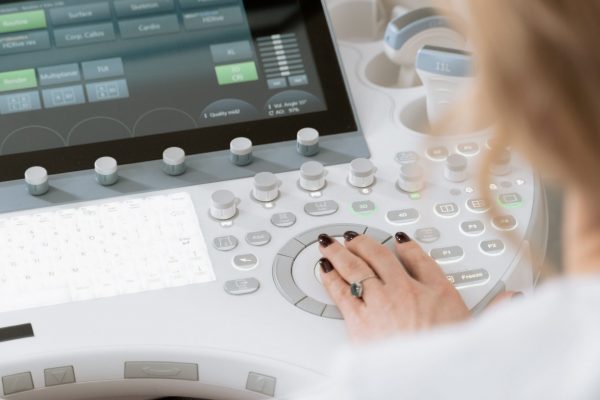Thanks to technology, we can visit doctors without leaving home, measure vital indicators with our smartphones or tiny wearables, and monitor the performance of implanted devices that keep our hearts beating. None of these, however, would be possible without using IoT in the healthcare industry.
IoT transforms the medical field by offering new ways to track health indicators, including heart rate, blood pressure, and oxygen levels, through wearable devices. Using remote patient monitoring systems, healthcare providers can now monitor chronic conditions without keeping patients in hospitals 24/7. There are also smart infusion pumps that can accurately deliver required medications, emergency response systems that allow professionals to access patient data in real-time, and many other innovative IoT solutions.
This article explores the influence of IoT on healthcare systems and smart devices enabled by this technology. Learn more about how the Internet of Things revolutionizes patient care, hospital operations, and public health in our post.
IoT in Healthcare Definition
Healthcare Internet of Things is the network of connected devices and software used by patients, physicians, hospitals, and clinical workers to care for patient’s health and optimize hospital management. Mobile apps, electronic healthcare records management software, and programs that connect to implanted pacemakers are just a few examples of IoT healthcare.
How does health IoT work? As wearables collect patient health information, they send it to the cloud and data analytics systems, which process, analyze, and share it with healthcare providers to assist them in making better treatment choices. The image shows how the IoT in healthcare functions and connects patients, devices, and medical professionals.
Internet of Things in Healthcare: Market Forecast and Endless Possibilities
With the smart hospitals market reaching $69.8 billion globally, medical IoT implementation attracts even more attention. As technologies advance and the adoption of smart hospital solutions increases, so do the IoT use cases in healthcare and their market share. Here are a few key stats illustrating the current trends:
The medical IoMT market consists of the following segments, depending on the technology use:
- Wearables: those that don’t have to be FDA-approved, like fitness trackers, and those that are considered medical devices, such as hip protectors, neurostimulators, etc.
- In-home: solutions that are parts of personal emergency response systems (PERS), continuous remote monitoring, telehealth, and virtual visits.
- Community-used: solutions that ensure the provision of mobility services, emergency and first aid help, kiosks, point-of-care stations, and logistics.
- In-clinic: IoMT for administrative or clinical purposes (virtual rooms, cloud-based examination platforms, etc.).
- In-hospitals: solutions for assets, inventory, personnel, and patient flow management (guiding systems, hygiene compliance alerts, etc.).
Each of these categories helps medical providers, facility workers, and patients improve the quality of care, awareness level, and reduce the delivery time. There are many approaches to developing IoT for hospitals or incorporating it into your practice, and the market opportunities are huge.
Core IoT Technologies in Healthcare
An IoT device cannot work on its own. It requires a complex multi-component system, including devices with smart sensors and the platform gathering and processing the collected data. To create such a system, you will need tech experts proficient in several core technologies we will tell more about below.
Smart Sensors
Smart sensors in healthcare Internet of Things systems allow real-time patient monitoring. For example, Zio Patch is an ECG wearable device that tracks heart rhythms and sends data to healthcare providers. The Dexcom G6, also known as a continuous glucose monitor, assists people with diabetes by monitoring blood sugar levels in real-time. Another great example of IoT in healthcare is Withings Thermo smart thermometer, a device that measures temperature and sends the readings to the personnel. Similarly, Evolv by Omron is an intelligent cuff that monitors blood pressure.
Communication Technologies
The IoT has been changing the healthcare sector, and communication technologies are essential elements of this process. Communication technologies allow for easy exchange of information among devices and healthcare systems for accurate monitoring, intervention at the right time, and more efficient patient care coordination.
- Wi-Fi is one of the most popular and fastest communication technologies in IoT healthcare because of its efficient and wireless connection. Using the IEEE 802.11 standards, Wi-Fi enables devices to communicate via short-range data transmission. Having appeared in 1997, Wi-Fi kept enhancing with newer standards such as Wi-Fi 6 and Wi-Fi 6E, which provided higher speed, improved security, and greater capacity. These improvements support high-speed connectivity and low latency, making Wi-Fi essential for real-time monitoring and data analysis in healthcare IoT systems.
- Bluetooth technology is commonly used in wearable devices such as fitness trackers and continuous glucose monitors. It enables devices to connect with each other up to a radius of 100 meters. Wearable devices that often have low battery capacity benefit from Bluetooth as it has low power consumption.
- Zigbee was developed for IoT healthcare devices such as remote patient monitoring systems. This communication technology that was released in 2004 is a low-power mesh network, which supports data transmissions and conserves energy with sleep modes, extending battery life. Its low data rate and cost-effective design make it perfect for long-term healthcare applications.
- Near Field Communication (NFC) is a short-range wireless communication protocol that enables short-range data exchange between devices within a few centimeters. NFC tags can be imprinted on wristbands and cards, enabling patients to be quickly identified. Additionally, NFC technology is widely used to securely exchange information between medical devices and smartphones.
Cloud Computing
Cloud computing provides an efficient solution to manage and store large volumes of data collected by wearable devices and medical sensors in a healthcare Internet of Things system. With the help of cloud technologies, healthcare professionals can remotely treat patients and receive real-time health data for enhanced health care delivery. In addition, cloud computing improves data security by protecting sensitive medical information, enables remote patient monitoring, lowers costs, and facilitates the deployment of new technologies. Learn more about our cloud engineering services.
Artificial Intelligence (AI)
AI algorithms can analyze vast amounts of data from IoT devices, recognize patterns, and provide real-time health insights, making IoT devices much smarter. This technology automates tasks like identifying health risks, predicting patient outcomes, and supporting remote patient monitoring, among other AI uses in healthcare. It ensures that medical service providers can make accurate and timely diagnosis, enhances provided care, and helps create effective treatment strategies.
Some other essential technologies for IoT are Blockchain, edge computing, and 5G. Blockchain facilitates the protection of patient information while edge computing accelerates data processing, and 5G improves connection and real-time communication, making healthcare IoT devices more efficient.
IoT in Patient Health Tracking
Approximately 80% of US citizens like remote patient monitoring, while more than half of respondents support using this method for medical care. IoT technology transforms patient health tracking, enabling continuous, real-time monitoring of health metrics. Smart devices help manage sleep patterns, improve treatment adherence, and bring other benefits, which we will talk about below.
Remote Health Monitoring
From monitoring vital indicators like pulse, blood pressure, and oxygen level to more complex solutions that recognize the patient’s facial expressions, mood, and psychological state — health monitoring devices and software are versatile.
Apple Health and FitBit trackers are the best-known IoT practices in health care. They track vital signs, help owners manage physical activity, and notify when the indicators go above the norm. Another example is Empeek’s cardiac care mobile device, an IoT solution that enables 24/7 heart tracking. It has become an alternative for in-hospital monitoring and enables patients to stay home while doctors receive the needed information for continuous monitoring.
Sleep Tracking And Therapy
Thanks to IoT in healthcare, healthcare providers can assess a patient’s sleeping patterns using smartwatches and fitness trackers. This helps identify sleeping disorders, such as sleep apnea or insomnia. Smart devices track the total sleep duration, quality, and even disruptions to create personalized health recommendations and reminders for better sleep hygiene.
Additionally, sleep therapy applications provide treatment plans, including cognitive behavioral therapy for insomnia (CBT-I). Sleep tracking strategies and therapies can help patients live healthier lives by aiding them with sleeping disorders and the consequences of chronic diseases that cause a lack of sleep.
Medication Adherence Tracking and Reminders
One of the most popular directions for medical IoT is administering drug usage. Not all patients adhere to medication regimens, which makes the whole treatment process less effective. Another issue is that many people, especially the elderly, have to be reminded to take pills. Add to that the growing number of the older population — and you’ll see why developing a drug management IoT solution is a good idea.
Proteus provides digestible Abilify MyCite sensor pills and a patch monitoring system to help patients with schizophrenia, bipolar disorder, and depression stick to their medication plans and monitor medication intake. The ingestible biosensor alerts when the pill dissolves in the stomach by transmitting a signal to a patch worn on the patient’s abdomen and then — to a smartphone to record adherence.
IoT in Hospital Operations
IoT technology enables hospitals to manage resources better, simplify operations, and reduce costs. Connected devices can also monitor important indicators of equipment to predict errors before they occur and monitor inventories.
Administrative Operations Automation
IoT devices can automatically record data in medical systems, reducing the workload of medical staff. Such automation brings many advantages, including less time spent on routine paperwork and more attention to patients. It also eliminates human errors, which at times can be life-saving.
Administering the medical office isn’t easy, specifically, if you need to do it all manually. Human errors are inevitable in this case, which is why automation becomes an answer. With a hospital information management system in place, routine activities like billing, making appointments, creating new patient records, adding the test results to EHRs, etc., take less time and optimize workflow.
Device Performance Monitoring
Smart beds and interactive monitors need continuous care and maintenance, which medical IoT solutions can ensure. Such IoT solutions assess the condition of the hardware and alert staff in case any fixing or check-up is needed. For example, the Philips e-Alert MRI system tracks the performance of an MRI machine and sends alerts if there is a critical issue. This solution allows for keeping the hardware running correctly for a longer time, which means less unexpected spending for hospitals and more effective patient care.
Hospital Infrastructure Management
Personnel, operating rooms, the hospital inventory, and even the lighting systems — all of those, when powered with IoT, can operate more efficiently and become easier to manage.
For instance, nurses have to manually track the capacity and the availability of beds in the hospital, which results in long wait times and speedy discharge. The adoption of an IoT-based tracking system automates this process, providing medical staff with real-time data on the current capacity.
Radio-frequency identification (RFID) tags and systems that monitor them are examples of the most widespread solution that tracks personnel, inventory, and patients. There are numerous use cases, from putting a tag around the newborn babies to avoid mixing up and a system that automatically locks the door if you try to take the baby out of the building to helping locate the closest defibrillator.
IoT in Public Health
IoT revolutionizes public health by enabling real-time disease monitoring and improving intervention responses. For instance, specialized sensors can measure air quality to reduce the risk of respiratory issues. They can also collect data to run large-scale analytics and identify trends within the population, helping public health officials make informed decisions about improving overall public health.
Disease Surveillance
Preventing the spread of diseases becomes easier with advanced technology. IoT devices and sensors help detect increased disease risks in real time by gathering data about patients and their symptoms. Not only does the technology help detect and reduce the spread of diseases, but it also keeps people safe. The example includes thermal imaging, which was used in public places and hospitals to detect fever, a common symptom of COVID-19. Such systems made it easier to protect public health through early diagnosis and isolating infected patients.
Outbreak Detection
One important application of IoT in public health is outbreak detection. IoT devices integrated with automated systems can gather patient information and relevant environmental features for early identification of potential outbreaks. Examples include systems that utilize data from hospitals and wearable devices to detect patterns and notify authorities during flu seasons or pandemics about the tendencies. These systems assist in speeding up the response to an outbreak and managing the spread of illness.
Empeek for healthcare IoT development
Empeek creates healthcare IoT solutions that advance patient experience, optimize hospital management, and improve public health. We design custom IoT systems relying on our expertise in smart sensors, cloud computing, communication protocols, and innovative solutions like AI.
Hire our healthcare IoT developers as a team extension or fully outsource software development to focus on your business goals. Here are some of our projects.
IoT Health Monitoring System
Empeek created an innovative IoT-based health monitoring system, which tracks real-time vital signs. It can measure the heart rate, blood pressure, oxygen level and body temperature and then transmit the data via communication channels to a cloud platform. The system includes a mobile app that enables users to monitor their vital parameters in real time and receive alerts on abnormal readings. The data is also accessible to the professionals which allows them to take actions if something abnormal was detected. Learn more about this case here.

AI-powered Heart Monitoring
Empeek developed a remotely controlled IoT health solution for heart health tracking. It consists of an AI-powered heart monitoring system and wearables. The system can collect ECG signals, heart rate, and other essential metrics, which are then analyzed by AI and machine learning to detect irregularities like arrhythmias. The system examines heart risks and sends alerts if abnormalities occur, enabling quick intervention and enabling 24/7 patient monitoring. Learn more about this case here.
Final Thoughts
Using IoT in healthcare isn’t just a cool thing to do — it’s a prerequisite for having one’s practice competitive in the market, delivering better care, and keeping the machinery in good working condition. Empeek knows how to implement IoT in healthcare and create IoMT solutions for medical providers that would ensure a better approach to delivering treatment, comply with regulations, and improve the overall customer experience. Contact us today for a free consultation. Let’s explore how IoT technologies can make your practice stand out!








